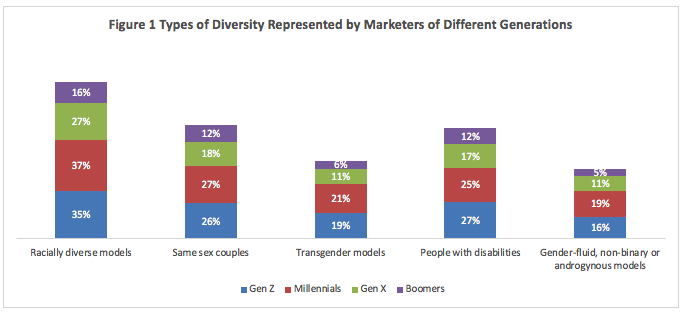Editor’s note: Shira Glickman is a research strategist at KNow Research, an insights consultancy based in San Francisco. Katrina Noelle is principal, KNow Research, and co-founder of Scoot Insights.
Diversity and inclusivity in advertising is a hot topic. Brands are keenly aware of the need to stay relevant and relatable to their target audiences. As insights professionals, we conduct studies to understand target audiences’ reactions to this updated representation of the world. Does the brand sound authentic? Relatable? In-touch? Trying too hard? Missing the mark?
Our goal is to examine the role brands (and their advertising/messages) play in reflecting and representing society through topics and imagery and how customer insights can help uncover best practices to do so authentically.
Shifting representation
We’ve seen brands lean into diversity and inclusion recently due to a few key factors:
- A belief that showing and including more diversity in the workplace and in advertising will help a brand’s reputation and success.
- A more recent recognition that everyone has biases, and belief that more exposure to diversity will help mitigate them.
- A belief that this is what work and society expects of them.
- A desire for marketing to reflect the world as they see it or want to see.
The data supports this and shows that these points are felt more strongly among younger generations. Millennials were initially the most diverse generation to date and Gen Z became the first to have a non-white majority. “These generations are looking for their own diversity to be reflected back to them in marketing, and in entertainment.” YPulse
Thus, nine in 10 of Generation X and Millennial marketers believe they are expected to use more diverse representation in their campaigns, and 88% of Generation X and 90% of Millennials believe that this helps a brand’s reputation.
Figure 1 shows how marketers across generations have actually been using diverse imagery In the last 12 months.

Joining the balancing act
Keeping up with changing norms and expectations in the way brands represent people is easier said than done. We’ve seen brands come up against a conflict of proportionality: finding the right balance between the real and the ideal, and in a way that’s authentic and not forced. Brands struggle with whether their role is to be an objective reflection of the world around us, or a change conduit by showcasing groups who have been left out of media historically with a social acceptance agenda. Many attempt to mitigate what they think is expected of them amidst an increasingly sensitive subjects that has many walking on eggshells – afraid of getting the balancing act wrong and falling off the tightrope.
We recommend brands find their balance on the inclusivity tightrope with good intentions and sensitive execution, with the following watch-outs:
- How it can help: As mentioned, younger generations are the most receptive and demanding of inclusion. Almost seven in 10 surveyed individuals between ages 18 and 34 prefer consuming movies and television featuring a multicultural cast and 65% were more likely to shop at retailers that offer a more robust selection of multicultural products. Furthermore, 72% of those age 13-36 said featuring diverse models in an ad would make them view a brand more positively, while 40% said featuring only Caucasian models would have the reverse effect.
Here are the brands younger generations are saying are succeeding in the inclusion effort:

Savage X Fenty: Rihanna’s lingerie brand is up at the top of the list for these generations and touted for going beyond just size and skin tone to featuring differently-abled and non-binary models. As Rihanna herself put it, “Last year, we laid the foundation for what the brand stood for… Here’s our bottom line: We’re inclusive. We want women to feel confident no matter what size they’re in. This year, it was about: How do we expand that? How do we make more women feel more confident?”
- How it can hurt: Be cautious not to cross the line into politics or take sides on contentious topics that don’t have universal acceptance.
- The Super Bowl this year showed prime examples. Pepsi’s halftime show had an undertone that appeared to speak in direct retaliation to the administration’s immigration policy. The Coke Super Bowl ad, which was a revival that sought to depict the melting pot of diversity found in America, backfired to those who thought it strayed too far from their ideals by featuring the classic American anthem, “America the Beautiful,” in different languages. Social media backlash resulted with #BoycottCoke.
Staying balanced
 We believe there are ways brands can effectively portray and convey diversity in their campaigns and messages. These best practices come from our work across multiple categories with diverse target audiences. It often comes down to a balancing act of communicating a core message while simultaneously expressing inclusive values.
We believe there are ways brands can effectively portray and convey diversity in their campaigns and messages. These best practices come from our work across multiple categories with diverse target audiences. It often comes down to a balancing act of communicating a core message while simultaneously expressing inclusive values.
Best practice No. 1: Be authentic and focused.
Case study: A business services provider wanted to promote a diverse and inclusive outlook that was in line with their brand values and company efforts in the special needs community.
Process: Participants reviewed campaign messages, taglines and benefit statements so we could understand which of the company’s attributes and assets had the strongest pull to new members. Sprinkled into the messages were statements about (a) their company’s inclusive and diverse staff and hiring practices as well as (b) their focus on supporting those with special needs/disabilities and their caregivers overall.
Insights: What was interesting here was that the company got credit for its programs and policies, but at the end of the day, participants also wanted to know about the nuts and bolts; fees, options, policies, etc., that would personally affect them and their families. The diversity and inclusion message was a good supporting point since it authentically reflected the brand’s core values, however, they wanted the central message to be about how they would be specifically supported by the company’s primary services. In this case, since they had an authentic company priority to lean on, they could lean on it gently.
Lead with the benefits and support it by policies and practices. It’s all about supporting without overwhelming the key attribute of your program, product or service.
Best practice No. 2: Lead with empathy.
Case study: A non-profit organization reliant on donations saw a lack of diversity in their donor base. For them this was more critical that a lack of diversity in appearance – they needed to attract a diverse donor base to serve the diverse communities that needed their services.
Process: Potential donors participated in a series of interviews and group discussions to (1) discuss their personal views on the subject of being donors, and how their views may or may not have been influenced from a cultural perspective; and (2) review all the clients’ collateral and materials include their website, social media messages and fliers.
Insights: While none of the materials were staged or intentionally placed to feature diversity, participants noticed the diversity in photos and video content. However they thought the images and clips were forced and staged. While people appreciate seeing marginalized and/or minority groups, it can backfire when these groups appear to be the focal point or intentionally inserted.
Insert diversity carefully and authentically to get credit for your efforts.
Best practice No. 3: Create unity.
Case study: A financial services company was putting together a new campaign and wanted all potential users to know how all-inclusive and accepting their offering was, both literally in terms of how many places accept their product, and figuratively in terms of catering to all types of people.
Process: Multiple advertising concepts were tested aimed at conveying the core message that the product was for everyone. Various creative routes reflected a message of acceptance in different ways and we listened to hear which messages resonated.
Insights: In this case, participants told us that presenting a message of unity, through humor in this case, mattered most. The strategy here is to veer on the safe side while still showing diversity, but without making the diversity aspect the focal point.
You can make the choice to unify instead of taking care to overtly and visually include images of all audiences; bring your audience together around a shared experience!
Listening to your customers
By now you may be asking, what can brands do today to check their balance? Consider the following ideas:
- Conduct an inclusivity audit on your campaigns and messages to ensure your efforts are being understood, appreciated and presented authentically.
- Promote your current diversity and inclusion programs and policies authentically.
- Showcase diverse employee and/or customer base in a way that’s realistic and proportional.
- Use diversity and inclusivity messages to support your key message rather than overshadow it.
- Ensure all photos, videos, testimonials and materials are authentic and attributed.
- If targeting specific sub-groups, talk to them first to understand their culturally-nuanced perspectives that can drive authentic messaging and visualization they will be receptive to.
Expectations shift rapidly, and category matters. Listen to your customers. Find out what they need and want to hear in your category and try to speak to those needs in an authentic way.
Sources:
